by Winding Pathways | Mar 11, 2021 | (Sub)Urban Homesteading, Birds, Pests
Millions of people love their cats. Some 36% of households keep an average of two cats. They are the second most popular companion animal in the United States, lagging only behind dogs.
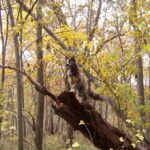
Cats decimate bird populations.
Some cats cause problems, especially when owners allow them to free-range the neighborhood. According to the American Bird Conservancy, they kill 2.4 billion birds a year and may be a significant cause of the decline of many species.
Catios to the rescue!
A growing number of cat lovers, many who also enjoy bird watching, recognize the problem and are increasingly adding a catio to their home. Wonder what it is???? It’s simply an enclosure that allows the family cats to enjoy fresh air, sunshine, and a bit of adventure without allowing them complete access to the neighborhood.
Many catios are enclosed patios, which spawned the name, that let cats play outdoors while their owners enjoy lounging or socializing nearby. They are relaxing places for both species. Other catios are small and positioned outside windows. Catios can be either purchased or homemade and often an existing patio can be modified into one.
Safety First!
Although cats love roaming the neighborhood, it is not a safe place. They pick up ticks and transfer them to humans, suffer accidents, are killed by cars as they cross streets, and are taken by predators.
A catio is a good solution to several problems. It allows cats to enjoy the outdoors safe from cars and predators in a place where they can’t kill birds. And, the owners always know where their cat is.
Harmony
An array of catio photos is visible on Catio Spaces. Many other websites feature them. Catios are a great way for cat lovers to show care of wildlife species, keep their cats safe, and live in peace with human neighbors who are frustrated when they spot a feline stalking birds under their feeder.
by Winding Pathways | Feb 18, 2021 | Birds, Geology/Weather
As we ate breakfast during the deep freeze that descended on February 7th six wild turkeys trudged through the snow from nearby woods and feasted on corn scattered under our bird feeders. It was 20 below zero – genuine 20 below. With the wind chill, the air was even colder.
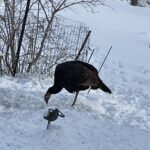
Warming toes.
The turkeys each stood on one leg as they pecked corn. Every once in a while, they alternated legs. One leg was always holding the bird upright while the other was tucked in the bird’s feathers. We wondered how they do this, so we went to our favorite new bird book, David Allen Sibley’s, What It’s Like to Be A Bird. According to him, birds have several adaptations that make it possible.
Here’s what he wrote, “The center of mass on their body is below the knee and a knob on the pelvis prevents the leg from angling any higher. Balancing on one leg requires angling that leg so that the foot is directly below the body, and with the leg essentially locked in position, and the body leaning against the leg, tiny adjustments of the toes are all that’s needed to stay upright.”
We often wonder how ducks and geese keep their legs and feet from freezing when swimming in frigid water or standing on ice. They have a useful adaptation. A bird’s leg is high, muscled, and covered with feathers. What we see that looks like a naked leg is actually a modified ankle, containing bones and tendons yet lacking blood vessels. So, the vascular area remains warm beneath feathers as the bird stands on the ice.
David Allen Sibley
We had the good fortune to chat with David Allen Sibley after he gave a presentation at the Outdoor Writers Association of America conference a few years ago. An astute ornithologist, writer, and artist, his books on bird identification and behavior, and his tree identification book, are always close at hand in our home. We’ve learned much from him.
Birds Need Grit in Winter
Most bird species need to occasionally eat tiny pebbles. These end up in the gizzard, a powerfully muscled pouch, where pebbles act like grindstones reducing hard seeds into a slurry for digestion.
During periods of snow and ice birds have a tough time finding grit, so about once a week we toss grit beneath the feeders. Sand works, but we usually use fine and medium-sized grit sold to help chickens digest their feed. Once the snow melts there’s no need to add grit, as birds easily find plenty of natural tiny pebbles.
-
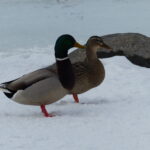
-
Adapted to the cold
-
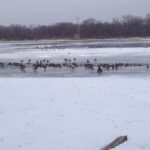
-
Weather adaptations
by Winding Pathways | Oct 8, 2020 | (Sub)Urban Homesteading, Birds, Garden/Yard, Nature
The August 10 derecho changed Cedar Rapids, and Winding Pathways wasn’t spared. We lost 47 of our 53 large trees during the 40-minute windstorm. It greatly altered our restoration plans. Here’s what we did or plan to do in response to the loss of trees.
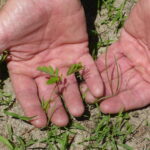
Prairie plant
New prairie plot: We planted this in early May. As expected, we only saw a glimpse of prairie plants in its first growing season, although early prairie plants give us promise that many more will appear next year. We will try to burn it either this fall or early next spring.
The derecho helped the prairie by felling or breaking four Douglas firs, one black oak, and one green ash. Two of these trees cast some morning shade on the prairie. The rest shaded it some in the late afternoon. They’re gone, so the site will enjoy more sunshine, and prairie loves sun. We mourned the tree loss but the prairie will benefit.
The trees didn’t go easily. Several tumbled into the prairie. They were big and filled with branches, leaves, and needles. We prioritized removing them. Many chainsaw and brush hauling hours later we had the trees moved into a big brush pile in the back. The sun now shines on the prairie planting. We’ll keep you posted.
-
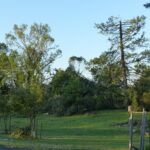
-
The firs and oak smothered the emerging prairie.
-
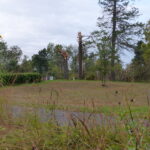
-
The firs shaded the prairie. Now more sun will shine.
Derecho Creates Opportunity
After we cleared fallen trees from the prairie, we turned to many trees that tumbled down on the north and east ends of our land. It’s taken hours to cut shattered trees and cut pathways through fallen logs so we can walk our own land easily. This land was once shady. Now the sun hits the ground. The storm transitioned the land from dense forest to savanna – a landscape of occasional trees and rich plant growth hugging the ground. Wildlife will transition as the habitat changes. Because of this change in the forest, some bird species may decline temporarily and others will thrive.
Open woodland birds: Robins, cardinals, white-eyed vireos, flickers, and Downey, red-bellied, and red-headed woodpeckers.
Mature forest birds: Scarlet tanagers, ovenbirds, wood thrushes, and pileated and hairy woodpeckers.
Shade and Sunshine
We didn’t lose all our forest trees. Just most of them. The loss of shade creates opportunities for ground-hugging plants to thrive, including baby trees. We’re already found some tiny black raspberry plants growing and many oak and hackberry seedlings.
To make sure that appropriate native savanna plants establish in the now sunny areas we ordered a native seed mix from Pheasants Forever that we’ll plant this fall.
We will keep you posted on changes in our prairies and new savanna.
by Winding Pathways | Oct 1, 2020 | (Sub)Urban Homesteading, Birds, Mammals, Nature
We’ll remember August 10, 2020, forever. On that day the wind changed Eastern Iowa and Winding Pathways in a way that will persist for a century. In 40 minutes, straight-line wind gusts up to 140 miles an hour toppled or broke 47 of our 53 trees. Two landed on our roof.
Our property adjoins Faulkes Heritage Woods, a 110-acre preserve of tall old trees, mostly oaks. The derecho felled most of its big trees that tumbled into a jumbled mass of trunks, branches, and leaves.
-
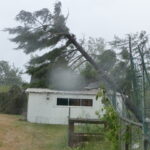
-
The pine toppled onto the cabin roof.
-
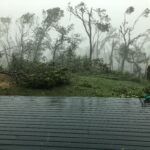
-
Effects of straight-line winds.
-
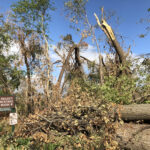
-
Twisted trees.
Wondering how the great change would impact wildlife, we quickly noticed two short term impacts. August and September are usually slow months for bird feeder visitors as birds normally have plenty of wild food. As soon as the wind calmed, all was still. Faithfully, Rich found and filled the feeders. The next morning, we noticed heavy use by house finches, titmice, nuthatches, cardinals, woodpeckers, and chickadees. It was almost like the feeding frenzy that happens as a winter blizzard approaches.
Short Term Impacts
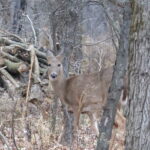
Trails are disrupted.
We quickly realized that deer, raccoons, coyotes, woodchucks, squirrels, and even chipmunks experienced a life-changing event. Their travel corridors changed as huge trees blocked deer trails, for example. They had to find new routes through the debris. One afternoon we saw a mother deer and fawn walking on the one remaining “open” trail around our prairie. Then, they crawled under a fallen tree and disappeared into the maze of branches. The ever clever raccoons have become more than pests as they tear up feeders and raid garbage cans. Also, the storm destroyed this year’s acorn and walnut crop, nuts that many species require. That is why the birds came so readily to the feeders. And still do!
-
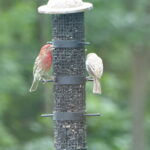
-
The house finches eat serenely.
-
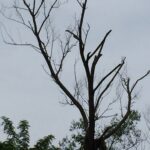
-
Even the crows come around to grab a snack.
-
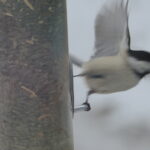
-
From early light to last dusk chickadees work the feeders.
Longer-Term Impacts
We are now watching for the long term impacts of the loss of so many trees. Our good friend, Jim Berry, is the former executive director of the Roger Tory Peterson Institute in New York. We asked him what we might expect following the loss of so many big trees in Faulkes Woods and our property.
“There are winners and losers. I would expect to see fewer wood thrushes, ovenbirds, and scarlet tanagers. They prefer mature forests. The more open woods and sunshine hitting the ground will cause an increase in cardinals, robins, and white-eyed vireos,” he said.
We have been fortunate to enjoy seven woodpecker species over the years. Some will benefit and some will lose from the great woods opening windstorm. According to Jim red-headed, red-bellied, and downy woodpeckers are likely to increase. So will flickers.
But sapsuckers and hairy and pileated woodpeckers that like the old trees and a closed canopy will probably decline.
-
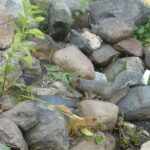
-
The small mammals are hungry.
-
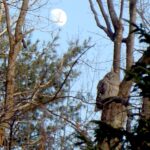
-
Owls will benefit from broken trees as cavities develop.
-
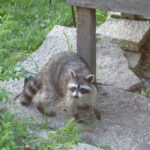
-
Raccoons ravage feeders at night.
The loss of hollow trees that shelter animals and the destroyed nut crop are going to make this a lean winter for squirrels. Deer, blue jays, woodchucks, chipmunks, and wild turkeys will also miss the acorns that normally rain down each fall.
We were saddened to lose so many trees but look forward to watching the forest restore itself. We’re also watching to see changes in wildlife.
by Winding Pathways | Aug 13, 2020 | (Sub)Urban Homesteading, Birds, Garden/Yard, Nature
This summer we enjoyed watching wren couples set up housekeeping at Winding Pathways. One pair nested in a small box under our porch ceiling, while another chose a box a few feet outside the dining room window.
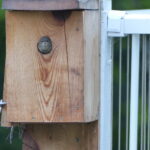
The world is big, bright and intriguing.
We watched these tiny, industrious birds make dozens of trips bringing sticks to make nests. Then, for a few weeks, we saw them infrequently. Only the female visited to lay eggs. Once her clutch was complete, she incubated them for a couple of weeks until they hatched. Then our fun began.
Wren parenting is hard work. Every two or three minutes one parent or the other brought juicy caterpillars and leggy bugs to feed the rapidly growing brood. Baby wrens hatch helpless and blind, but in just a couple of weeks, they grow almost as big as mom and dad. Finally, it’s time to fledge.
On the morning of August 9, we sat on the deck watching a young wren peer out the entrance hole, begging for breakfast. Mom or dad brought bugs, but mostly they urged the youngster, and its siblings, to take the plunge and abandon the only home they knew.
It’s scary. The nest is secure and safe. Mom and dad bring food and keep it clean. Then they expect their kids to leave and earn their own living in a world fraught with danger.
Our young wrens peered outside for a day or two before fluttering into the world. Huddling in low lying vegetation they called hungrily. Fortunately for wrens and many other birds, the adults help them out. We continued to hear these “branchers” calling in the nearby woods and caught glimpses of the parents bringing bugs to them. Slowly the babies figured it out.
After a few days, the young re-appeared around the yard, flying awkwardly. They have much to learn, and all sorts of perils to avoid. The parents continue to support them and many will wing south as the weather cools. We’ll watch for their return next April.
This year millions of American teenagers and new college grads are in the same fix as young wrens. Childhood and Youth are over. Peering out the door and knowing they must leave is scary. It’s tough enough to leave home during normal times, but this year coronavirus is making the transition extra challenging.
Young people heading for college don’t know whether classes will even be held. If so, will they be online or in-person? Will college include exposure to a virus that could sicken or kill? Recent high school and college grads seeking a job face different challenges. High unemployment and lurking viruses can make finding work difficult and, perhaps, dangerous. Join the military? Move across the country for a job? That’s perilous, also. Nothing seems safe. Everything’s confusing.
Like the young wrens, parents still help guide their offspring, providing support, advice, and encouragement as the “young” leave the nest. We send good wishes to the youthful wrens that started life at Winding Pathways and to young people about to launch into a confusing and challenging world. May they all thrive.
-
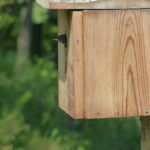
-
This baby is checking out the scenery.
-
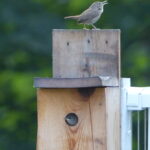
-
Parent encourages the baby.
-
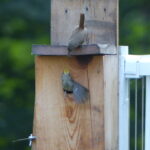
-
The parent dangles tasty morsels, forcing the baby to come outside the nest box.
-
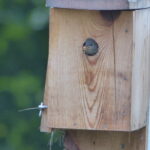
-
This huge bug is a mouthful!
-
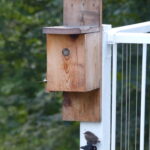
-
A short first flight.
-
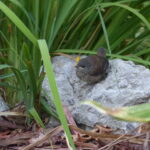
-
This wren fluttered to the ground below the next box.
by Winding Pathways | Jul 23, 2020 | (Sub)Urban Homesteading, Birds, Garden/Yard, Nature
Chickadee Delight
Guest Blogger Jackie Hull
There is nothing that can surpass the natural ebb and flow of life passing by one’s window every day. The early morning symphony of spring birds creating their own composition of sound as each species awakens to another day. The goldfinches, chipping sparrows, Indigo buntings, robins, flickers, wood thrushes, chickadees, pileated woodpecker, nuthatches, downy and hairy woodpeckers, crows, hawks, catbirds and the unflappable mockingbird all announcing to the world that it’s a new day. Up and at ‘em!”
Grand Symphony
One particular morning after this grand symphony I noticed a chickadee zip into the mimosa tree near the back door. As he teetered on a branch, he seemed to be checking out the birdhouse attached to the side picket fence that surrounds our cottage garden. The chick came in for a closer look as he landed securely on a fence post. Then straight as an arrow, he went through the birdhouse entry for the final inspection.
Apparently the abode met with approval. Soon the male and female chickadees were padding the floor of the birdhouse with moss from the woods across the pasture. Diligently they flew to and from the woods with beaks full of moss. At one point my curiosity coaxed me to peek inside the box to view their progress. The moss-covered the floor and they had begun twining fine grass strands into a circle. One of the chickadees caught me and scolded me soundly for peeking.
Mid-Day Lull

Taking wing
Mid-day that there didn’t seem to be much activity. As soon as the sun began setting, the chicks stepped up their construction. Again my curiosity pushed me to the birdhouse. I opened the door. To my complete delight, I counted six cream-colored eggs with soft brown speckles nestled in a perfectly round cup of grass. Of course, the chicks caught me again and proceeded with another scolding. I retreated to the back step.
Every day I waited impatiently for the hatching. The male came regularly with worms to share with the mate. He would give a clear whistle and then softly chat before he popped into the house. It seemed to me that this breeding process was taking too long. Once more I peeked. Six chicks opened wide their beaks and begged for food. This seemed like the last straw to the doting parents. They clamored about chattering at me. Again I retreated and watched from the back step.
Frantic Fledging
This preparing the chicks for fledging began at dawn and continued until dusk, quite a marathon. First, one adult came with beautiful green worms to be popped into the loudest mouth. The adults always announced that they were coming as they hopped from crepe myrtle to post and always bull’s eyed the doorway. As quickly as they entered, they were gone to forage for more bugs and worms.
One morning several weeks later I noticed a chick teetering in the doorway. The chick quickly retreated because that nosy woman was at the back door again. Sensing I was on the inside looking out, he hopped onto the door lip. Within a matter of minutes, he flew out the doorway, trying desperately to cling to the slippery vinyl house siding. In a twinkling of an eye, one of the adults was there to guide the fledgling to the butterfly bush. The chicks’ tail feathers were a bit short, but using every ounce of energy, the chick followed the adult across the yard into the wild rose bush.
Appreciation of Little Moments
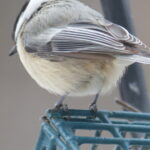
Chickadees grasp suet feeders
This was certainly a morning of the natural ebb and flow of life. If I decided to leave the back doorway, that moment would have passed me by forever. Such a glorious moment I would have missed. Within three hours the other chicks had flown away following their parents into the woods further down the lane. I could hear them chattering to the chicks and the chicks answering them. They have gone on now leaving me to ponder the wonder of life. It was a special event to have had this chickadee pair decide it was just fine to nest so near my back door.
I will always cherish the sheer joy it gave to me.


























